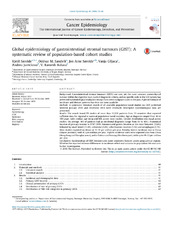Global epidemiology of gastrointestinal stromal tumours (GIST): A systematic review of population-based cohort studies
Søreide, Kjetil; Sandvik, Oddvar Mathias; Søreide, Jon Arne; Giljaca, Vanja; Jureckova, Andrea; Bulusu, V. Ramesh
Peer reviewed, Journal article
Published version

Åpne
Permanent lenke
https://hdl.handle.net/1956/11924Utgivelsesdato
2015-02Metadata
Vis full innførselSamlinger
Originalversjon
https://doi.org/10.1016/j.canep.2015.10.031Sammendrag
Background: Gastrointestinal stromal tumours (GISTs) are rare, yet the most common mesenchymal tumour within the digestive tract. Lack of diagnostic criteria and no specific code in the ICD system has prevented epidemiological evaluation except from overt malignant cases in the past. A global estimate of incidence and disease patterns has thus not been available. Methods: A systematic literature search of all available population-based studies on GIST published between January 2000 and December 2014 were reviewed. Descriptive epidemiological data are presented. Results: The search found 29 studies of more than 13,550 patients from 19 countries that reported sufficient data for regional or national population-based statistics. Age at diagnosis ranged from 10 to 100 years, with median age being mid 60s across most studies. Gender distribution was equal across studies. On average, 18% of patients had an incidental diagnosis (range from 5% to 40%). Anatomical location of primary tumour in 9747 GISTs demonstrated gastric location as the most frequent (55.6%) followed by small bowel (31.8%), colorectal (6.0%), other/various location (5.5%) and oesophagus (0.7%). Most studies reported incidence at 10–15 per million per year. Notably, lowest incidence was in China (Shanxi province) with 4.3 per million per year. Highest incidence rates were reported also from China (Hong Kong and Shanghai areas), and in Taiwan and Norway (Northern part), with up to 19–22 per million per year. Conclusions: Epidemiology of GIST demonstrates some consistent features across geographical regions. Whether the reported extreme differences in incidence reflect real variation in population risk warrants further investigation.
